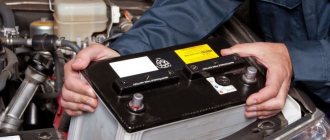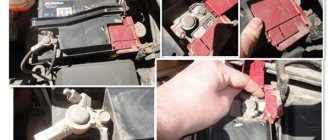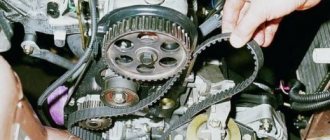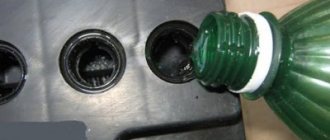What to do?
The very first thing you need to evaluate is the solution, it could be black, just cloudy, gray.
Also, are all the cans the same color or just one? This means that you used a low-quality fluid, the solution is simple - you need to replace it. We simply pump out the old electrolyte and fill in the new one. If during further use it remains light, it means you simply poured the wrong water inside.
First you need to try to charge it, most likely these are simply crystals of sulfuric acid salts. This happens with deep discharges. If it doesn’t help, then we change it to a new one.
If one jar turns black, the rest are fine - we manipulate it. If possible, try taking voltage readings from it, they should be approximately 2.1 Volts. Often there is no voltage in it at all, or it is minimal, about 0.5 Volts, and the total for the entire battery is about 10 - 10.5 V.
There are several reasons for this phenomenon. Many people believe that the whole issue is dust that got into the battery banks. However, this happens extremely rarely, especially when it comes to maintenance-free batteries, which are actually sealed containers. Therefore, we immediately cut off this reason.
If the liquid is cloudy, then it is worth remembering what kind of water was used when servicing the unit last time. You need to remember once and for all, you cannot use tap water, even if it looks very clean and transparent (and even more so process water). Only distilled liquid is suitable.
Sometimes the electrolyte remains relatively transparent, but inclusions appear in it, which form a precipitate. This indicates that we had to deal with sulfation of the plates.
If the liquid becomes cloudy and acquires a gray or lead-like tint, this indicates a severe discharge of the battery. Fortunately, all these problems can be solved on your own, without replacing the electrolyte or buying a new battery.
In order for the resuscitation of a car battery to be successful, you will need a sufficiently powerful voltage source with a voltage of at least 20 V and a current of about 80A. Next, you will need to open the plugs and carry out reverse charging by connecting the plus of the charger to the minus of the battery, and the minus of the power source to the plus of the device.
Read more: 2020 Audi A4 - what the updated model will be like
During this process, the device boils, but this is quite normal. Charge the battery for about 30 minutes, then drain the electrolyte, wash the device with boiling water and fill in a new catholyte. The next step is to connect a regular charger with a current of up to 15A and charge the battery during the day.
To begin with, you should use standard prevention methods. That is, add electrolyte as necessary or simply dilute the acid with increased density with special distilled water.
You should also use a charger or simply try to replenish the charge if it drops below the permissible values, due to the active operation of the generator.
When such measures do not help, we have to look for alternative ways out of situations.
The characteristics of the changing electrolyte may vary. Experts distinguish several options:
- gray working fluid in the battery;
- cloudy mixture of acid and water;
- brown electrolyte;
- black liquid.
Each option should now be considered separately, depending on the color.
In its normal working state, the acid-water mixture has no color, that is, it remains completely transparent.
But it happens that motorists notice changes. This happens in one car battery bank or in all of them at the same time, when the electrolyte is completely painted dark gray.
In this case, the most likely cause will be a strong discharge.
To return the battery to service, it is recommended to drain the old working fluid, and then fill in a new, fresh and high-quality mixture of purified, prepared acid and distillate.
After this, cyclic charging is required. Current and voltage are selected based on the recommendations prescribed by the manufacturer.
Cloudy color
It also happens that cloudy, as if dirty, electrolyte appears in one battery bank or in several battery banks at once.
If a cloudy mixture is detected during testing, this may be due to the use of a low-quality acid-water mixture or the use of tap water poured literally from the tap.
Read more: Lubricating battery terminals - 10 products that can be used to lubricate against oxidation
It also happens that turbidity appears in the entire battery, that is, when checking all available cans. In this situation, the problem is more likely to be the low quality of the purchased battery.
To restore the battery's functionality, you can replace the mixture of water and acid, and then follow the charging procedure according to the instructions.
Brown
And in some cases, the acid-water mixture has a brown tint. It is quite easy to distinguish it from a gray or simply cloudy electrolyte.
The main reason that the fluid turns brown is that the battery is overcharged. Or the plates were severely exposed during charging due to a lack of electrolyte.
It is best when the problem is observed only on the side of one can and the brown color is not very saturated. Then the problem can be solved by adding fresh electrolyte.
If the shade is dark enough, you will need to completely change the composition of the acid and distillate used in the entire battery, and then carry out a sequential charging cycle.
Black
Motorists have repeatedly noted that when opening the battery, they noticed black electrolyte in the battery of their vehicle. And here it is logical to ask what to do in such a situation.
An acidic working fluid that has turned black is unlikely to be restored. That is, a complete replacement will be required here.
Blackening of a mixture of acid and water is possible when the plates are destroyed and lead particles accumulate at the bottom of the cans.
It is lead that contributes to such intense coloring.
If blackening is observed in only one of the cans, first try replacing the working fluid there. In some cases, it is actually possible to restore the operation of the device. But this is only allowed in a situation where there is no short circuit between the plates.
Otherwise, you will have to completely change the entire electrolyte or the battery itself with a new one. Shedding of lead-based internal plates is a strong argument and reason to think about buying a new car battery.
Read more: Review of automatic charger for car battery
Sometimes the driver removes the battery or connects the charger directly in the engine compartment. This is required to replenish the required charge level, since during short trips over short distances the generator does not have time to fully replenish the battery. But it is during charging that for some reason the electrolyte inside the battery becomes cloudy.
In the vast majority of cases, cloudy electrolyte during charging is caused by incorrectly set charging current.
All specialists and ordinary experienced motorists know that charging is always carried out at 10% of the current of the battery’s rated capacity.
However, this procedure usually takes about 10 hours.
If the liquid darkens during charging, check that the charger is set correctly and make sure that you are not over-charging the battery.
Cloudiness and discoloration of the working fluid in the battery cannot be called a pleasant phenomenon. Yes, this is not always critical, and sometimes the situation can be changed by partially replacing the working electrolyte in one of the available cans.
It is extremely important to monitor the state of the mixture of acid and distilled water, maintain optimal proportions between acid and water, and also do not forget to periodically check the charge level in the battery. It is not always possible to replenish it through the operation of the generator. Therefore, having a charger often helps to get out of the current difficult situation.
It’s never a bad idea to have a container with electrolyte and regular high-quality distilled water on hand. But all this is relevant only if there is a serviceable type of battery under the hood of your car.
The driver’s further actions depend on the state of the electrolyte. The colors of the liquid often indicate the reasons. It is also necessary to take into account whether changes have occurred in one jar or whether the electrolyte composition of the standard battery has darkened in several containers.
Add new electrolyte to the battery
What to do when black liquid is detected? It occurs due to low-quality distillate. This means that when topping up, the motorist used a cheap or incorrect composition. We'll have to change it completely.
Carefully drain the dirty mixture from the battery cans, and then pour in a new solution, remembering to use personal protective equipment. When, during subsequent operation and inspections, no clouding is detected, this is a sign that the preventive measures taken were correct.
If we notice a bluish cloudy composition of the electrolyte in the battery, then in this case crystallization of sulfuric acid has occurred. First, we recharge the battery, because turning blue is a sign of active battery discharge. The measures may not help, so we change the electrolyte that has darkened in the battery, and after adding new liquid, we use the charging method with weak currents, alternating charge and discharge.
Motorists can detect black liquid (contaminated electrolyte) not in all battery banks, but only in one of them. You will need to measure the voltage in it. The optimal value should be 2.1 V. If you manage to reach the nominal value, you will be able to save the entire battery.
When a voltage not exceeding half a volt is detected in a problematic capacity, and at the same time for the entire battery it does not exceed 10.5 V, then this is evidence of falling plates. Lead precipitates and turns the liquid dark.
Types of car batteries
All car batteries presented on store shelves can be divided into two types:
Classic battery with factory access to banks
- Serviced models - the body of such a product provides access to the electrolyte, which allows you to check its density and take samples to analyze its condition. If the need arises, the factory fluid can be drained, replaced with a new one, or simply topped up.
The body of such a device does not have screw caps and is sealed
- Maintenance-free models - what distinguishes them from the previous ones is that they have a completely sealed case, that is, the user does not have the opportunity to get to the electrolyte without interfering with its design. However, such models can also be charged.
Advice! If you break the seal of such a battery (by drilling holes) in order to get to the electrolyte, then after all the manipulations it must be sealed again.
When to add electrolyte
Electrolytes for acid batteries
Why do we need electrolyte in batteries? Let's talk about everything in order!
- Let's start with the fact that the battery itself is designed to accumulate sufficient electrical charge due to the chemical reactions that occur between lead plates, which many probably remember from childhood, when they were melted into interesting figures, and the electrolyte. These reactions are excited by the flow of electric current.
- When starting the car, current begins to flow to the battery from the generator. The same thing happens when we connect a portable charger instead of a generator. As a result, the charge accumulates in the device to a certain level.
A common pattern observed in winter
- However, over time, the battery's capacity begins to decrease and the charge is poorly retained, and sooner or later, when trying to start the car, you will realize that your source of electrical energy has dried up.
- This happens, as already mentioned, for various reasons. The most common reason is loss of density in the electrolyte, which occurs due to aging and sulfation of the plates. An important role in this case is played by under- and overcharging of the battery.
The inner world of an acid battery
- Sulfation is a process that occurs as a result of undercharging a battery. Inside the battery is filled with special grids containing lead dioxide. When the battery is charged, lead oxide is reduced at the cathode, and the oxidation process is also activated at the anode. Essentially, these are the primary plus and minus in the classical sense.
Lead plates from a battery
- If the charge is insufficient, lead sulfate begins to form intensively, which causes a decrease in the density of sulfuric acid, which is the basis of the battery electrolyte.
The hydrometer allows you to measure the density of electrolyte and antifreeze
- To check the density of the electrolyte you need to acquire one simple device - a hydrometer. If after the measurement you see that this indicator is below the norm (1.27 gcm3), then it needs to be raised to the optimal value. We'll talk more about this a little later.
What to consider before replacing/topping up electrolyte
In the photo - measuring the voltage level.
This chapter will contain a set of important tips that should be kept in mind during such events.
- Firstly, you should not add electrolyte immediately after measurements to the battery installed in the car. This is the most common mistake made by beginners. The fact is that when fully charged, the density of the electrolyte will change.
- Secondly, you need to remember that the electrolyte level in the banks must be strictly defined, otherwise the sulfation process will not stop, and the battery will soon fail.
Advice! If the density of the electrolyte is within acceptable limits (1.27 - 1.29 gcm3), then the electrolyte is simply topped up to the required level and the battery is used further in normal mode.
- If during measurements you find a decrease in density, then before doing anything, you should run the battery through a full charge and full discharge cycle several times, then repeat the measurements and add new electrolyte, bringing the density to the required level.
- If the density of the electrolyte is higher than normal, then distilled water is added to the battery, that is, it is diluted. Do not try to fill the battery with ordinary tap water, as this will most likely result in sedimentation, which can have a detrimental effect on it.
- It is very important to know how much electrolyte the battery requires. This information should be in your head both when replacing and when adding electrolyte. Information can be obtained from battery sellers, on the manufacturer’s website, or amateur car forums and other sources.
Advice! Usually, by unscrewing the caps that close the jars, you can see marks indicating the required liquid level. If there are no marks, then when refilling you can guide yourself this way - pour until the cans close by 5-7 mm.
- The fluid level should not be higher than normal. You need to ensure that there is about 2 centimeters of space left before the cork is cut.
The concept of a quality electrolyte
Before drawing any conclusions about the condition of the battery, you need to figure out what color is considered normal. Based on this, it will become clear whether there really are problems in the battery.
The battery uses a mixture based on pure distilled water and sulfuric, but not hydrochloric, acid, mixed in certain proportions.
Distilled water naturally has no color or odor. Concentrated prepared acid also has no color, plus there is a subtle odor.
Mixing these components does not change the situation. Therefore, the electrolyte in its normal state remains a colorless, odorless liquid.
If during normal operation or while charging the battery the color of the mixture changes, this indicates the presence of certain problems. It is necessary to understand what causes the color change and how to eliminate such a malfunction.
Simple Troubleshooting
If you can determine that the battery is discharged, then in this case it is enough to connect the battery to the power supply and wait a while. As the charge is received, the liquid will restore its color.
When sulfating platinum, it is necessary to perform more complex manipulations. First you need to rub the battery a little. After that:
- Add a small amount of distilled water to the battery to bring the electrolyte level to normal.
- We connect the battery to the charger (it is recommended to set it for eight hours).
If during charging the electrolyte temperature exceeds 43 degrees, then it must either be kept at this level or reduced slightly. However, at this stage it is important to ensure that the voltage in one of the battery jars does not drop to a level below average (up to 0.2 V). If this happens, you must immediately stop the procedure and take the battery for repair or replace it.
Things are much worse if the electrolyte in one or several battery containers has not only lost its transparency, but has completely turned black. In this case, the problem is explained by the fact that the so-called coating of the plates (essentially lead oxide) of the battery has crumbled or the device was operated in a discharged state.
Let's sum it up
As you can see, cloudy or gray electrolyte is not always a sign of final battery failure without the possibility of recovery. In this case, you need to take a comprehensive approach to the maintenance issue, that is, wash the sections, fill in fresh electrolyte according to the level, and adjust the density. Next, you need to properly charge the battery.
If blackening of the electrolyte is noted in one or more banks, and the voltage is low or absent, then this indicates active shedding of the plates. For a number of reasons, it is better not to waste time trying to restore such a battery, since even if positive results are achieved, there is no confidence that the device will continue to operate normally for a long time (especially in low temperature conditions).
It turns out that if the gray electrolyte is not yet so critical, the black electrolyte in the jars is already a good reason to scrap the existing battery and purchase a new battery. We also note that if there are problems with the generator in the car itself or when charging from the charger the battery is not charged correctly, then the new battery will quickly fail.
Reasons for changes
Experienced motorists know that the battery is filled with a clear liquid, which is a mixture of distilled water and sulfuric acid, combined in a certain proportion. The solution in each new battery is absolutely transparent, because it does not contain any dyes or chemical additives.
Destruction of battery plates
With proper operation and in good condition, the working electrolyte in the battery banks will continue to be cloudy, and the reasons for the loss of transparency can be various factors. It is important to pay attention when negative factors appear that cause the electrolyte to darken. This may not happen in all jars at the same time, but only in one of the working containers.
In this case, there is nothing unusual, because the electrical appliance is designed for a certain period of use, and after its service life expires, it is completely replaced, and not restored to its operational characteristics. In fact, the owner has no ability to influence the composition of the solution.
Users of maintenance-free devices sometimes experience cloudy liquid composition if owners drill holes in any cans and then do not seal them well. You should not do this unless absolutely necessary, since third-party interventions usually do not lead to a positive result.
In a serviced battery, you are less likely to encounter cloudy electrolyte, since the reason lies in regular monitoring of the fluid by users. By unscrewing the plug, the car owner can check the condition at any time and take the necessary measures in a timely manner.
Popular causes of cloudy fluid in the battery include:
- For old batteries with a long service life, a popular cause of contamination is the penetration of small debris and dirt into the container. This occurs due to wear of the plugs or under-tightening of the threads, as well as due to self-unscrewing.
- When charging the battery, the liquid inside may boil and evaporate. Then the owner adds water. If it is not distilled, then the salts present in it can lead to deposits during subsequent charging. Further impurities give rise to turbidity.
- You should not use low-quality ready-made electrolytes in unknown places. Even with a short period of use, the composition can lose transparency and quickly fail.
The problem with cloudy liquid can be solved by completely replacing it with fresh one. In this case, it is necessary to observe the proportions when preparing it yourself. After changing the composition, the battery is suitable for further use.
If preventive measures are not taken, the battery will overcharge and further overheat. Excessive temperature will cause the solution to change color to a darker shade. Deviations in the operation of the on-board power supply will affect the performance of the generator, relay regulator, and external charger. The composition can also negatively affect the built-in plates inside the case, which will lead to their further destruction.
Checking the electrolyte for replacement
The color change occurs due to the destruction and splitting of the plates. This happens due to a significant discharge of the battery. This changes the color of the liquid.
A decrease in density affects the possibility of freezing of the composition at low temperatures. Increasing the amount of water in the composition in this way can lead to mechanical destruction of the walls of the cans and the body as a whole when freezing.
In some cases, the transparent electrolyte begins to take on a cloudy tint. Why does this happen and how can you eliminate the problems associated with it?
The electrolyte may become cloudy for the following reasons:
- Dirt getting into the battery. This is the most common cause of darkening of the mixture;
- Adding water with foreign impurities. Sometimes the water may contain high levels of chlorine or iron, which will affect the appearance of the solution;
- Use of low-quality electrolyte. Most often, this problem occurs when you independently add a low-quality solution;
- Recharging the battery. In this case, a color change may occur due to the penetration of parts of the grease from the electrodes into the electrolyte. The main reason for overcharging is a faulty generator, as well as charging with low-quality chargers, poor operation of the relay - the “pill” regulator, or constant use of the battery, since in this mode it does not have time to cool;
- Temperature increase. This problem is relevant in the summer, since in extreme heat the electrolyte can become very hot. A temperature of more than 35-37 degrees is considered catastrophic for it, at which the processes leading to wear of the electrodes are most strongly activated;
- Replacing distilled water with tap water. Tap water contains impurities and metals, which cause the electrodes to fail faster;
- Constantly discharged battery. For this reason, the density of the substance decreases, it changes appearance, and the energy characteristics of the battery are greatly reduced;
- Defrosting the battery. This problem is typical in winter, when after severe freezing, the monoblock bursts during the defrosting process of the battery. Very often, after thawing, the electrolyte begins to leak out.
As a rule, one or more of the above reasons can lead to a change in the color of the electrolyte. Some of them lead to complete wear of the battery, and sometimes it is enough to eliminate them to give the solution its original color.
The appearance of cloudy electrolyte in the battery during charging, as well as simply during standard operation, can be due to several reasons.
It is important to understand here that the battery can be charged naturally during everyday use, that is, due to a running generator or by connecting a charger. In both presented cases, it is relevant to talk about the appearance of dark or black electrolyte in the battery when charging it.
If we talk about why an uncharacteristic cloudy electrolyte appears in a car battery, then we should highlight the following possible reasons.
- Violation of tightness. This may be due to a violation of the integrity of the filler plugs, improper tightening, or some damage to the housing. As a result, contaminants, lubricants, and coolant penetrate inside. Mixing leads to a change in color.
- Using poor quality water. If the electrolyte darkened literally immediately after adding fresh distilled water and this was detected when charging the battery, then the reason may lie precisely in low-quality water. Some motorists, in order to save money or due to the lack of an alternative, use regular tap water instead of distillate. Although some sellers sell more tap water under the guise of distillate. The option of purchasing low-quality electrolyte cannot be ruled out.
- Buying a low quality battery. This may turn out to be a banal fake, a battery that has been in a warehouse for at least 6-12 months. Even if the production date is fresh, but the storage rules were not followed, after the start of use of such a battery, the liquid inside may darken.
- Battery overheating during charging. The main reason why black electrolyte may appear in a battery during charging is due to violation of the charge recovery rules. Severe overheating occurred, which provoked the corresponding changes.
- Strong discharge. It is also called deep. May cause discoloration. Usually occurs due to the inattention of the driver himself, who leaves consumers turned on while leaving the car.
Obviously, dark electrolyte is not normal in a battery. Understanding why this situation can occur, appropriate recommendations have been developed to prevent problems from occurring.
Next, we should consider several situations when, during operation of the generator or during charging from the charger, the electrolyte in the battery suddenly darkens.
Much depends on what specific condition you are faced with. There are several possible options here.
Understanding what it means when the electrolyte inside the battery becomes cloudy, and perfectly assessing the degree of danger of such a phenomenon, you should develop a further action plan. Let's look separately at what to do if the color changes during charging.
To be honest, there is only one reason why the electrolyte turns black, and it often manifests itself in a working battery that you have not tampered with (a maintenance-free battery). But in fairness, it is worth noting that if the battery is constantly checked by you, that is, it is serviced, there may be many more reasons and they are not always critical.
"Easy" reasons:
- It is commonplace for dirt to get inside, this rarely happens, and where there is dirt you should not expect a light solution.
- Using non-distilled water. For example, you simply fill it from the tap, or you take other technical water - this will lead to the formation of impurities during charging. And such impurities can lead to turbidity, the moral is this - make sure that only distilled liquid is added.
- Poor quality electrolyte. Made I don’t understand where, and I don’t understand by whom. It is quite possible that non-purified components were used, for example water.
As you can see, these are fairly easy and quickly fixable problems. You need to replace low-quality fluids with proper ones, the problems will go away.
"Complicated" reasons:
- Battery overcharging and temperature rise. Often, heating the battery leads to a change in the color of the electrolyte. Already at 37 - 40 degrees, the color can change critically, and the process of destruction of the plates begins, although not so fast. That's why summer and overcharging are detrimental to the battery. When recharging, the plates also heat up, which increases the temperature of the electrolyte.
- Deep discharge of the battery. As with overcharging, the plates also begin to break down, which changes the color of the electrolyte.
- After the battery freezes. If you remember, I wrote in this article that when deeply discharged, the battery may freeze. This is quite real, the density of the acid drops, and the water does not maintain extremely low temperatures. So the ice that is inside can damage the plates and the body itself. Therefore, after freezing we get a cloudy electrolyte.
Cloudy electrolyte in the battery - FordLab all about Ford cars.
Cloudy electrolyte
Inside a new battery is a clear electrolyte, when this active material can no longer support the discharge current, the battery "dies". Typically, a battery "ages" when the active positive plate material is lost (or peeled off) due to the normal expansion and contraction that occurs during discharge and charge cycles. When the container is lost, a brown (brown) color called sludge or "dirt" may appear that accumulates in the bottom of the housing. So let's talk about cloudy electrolyte, how to prevent and eliminate it.
Why is the electrolyte cloudy?
The most common cause of cloudy electrolyte is simple dirt. The reason is trivial, but if dirt gets inside, the performance of the battery will deteriorate and will need to be replaced.
The best batteries
A cloudy electrolyte may appear due to topping up distillate. Adding distillate with the wrong chlorine and iron content will result in a cloudy appearance. We do not recommend taking a poor quality distillate, and do not mess with the electrolyte at all (it may have the wrong composition/density).
If the reasons described above do not apply to your situation, then it could become cloudy due to overcharging. When recharging, the grease sheds from the plates, the sediment of which gives a brown color. Recharging may be due to poor battery charging, or the battery does not have time to recover from travel or due to increased/lower temperatures. In summer, a cloudy tint appears due to strong heating, and in winter, a common cause is thawing of the battery.
Read where to find the radio code for Ford Focus 2
ATTENTION! You cannot fill the battery with ordinary water. Ordinary water contains all sorts of impurities and metals
Gray shade
In this situation, your battery contains a lot of insoluble sulfates. You need to fully charge the battery and the color should be restored.
Electrolyte recovery
Yes. It can be restored, although not always. Before restoring the electrolyte, you need to find the cause of its cloudiness. In the best case, with a gray tint, you will only need to charge it, and in some cases, buying a new battery will help.
Electrolyte replacement process
Blackening of the electrolyte
If the liquid has acquired an alarmingly dark color, then you should first consider the possibility of shedding of the spread. In half the cases of such problems, everything is explained by the fact that the electrodes are covered with rust due to their advanced age. Constantly collapsing, they began to partially turn into dust, which settled in the separator bags.
If a discharged battery was used, this could also lead to shedding of this material (which happens in 50% of cases). The fact is that, in terms of its chemical composition, a discharged coating (not yet crumbled) differs from a charged one. In the first case, it does not stay on the plates for long and quickly crumbles. This explains why it is strictly forbidden to shake a discharged battery vigorously.
Interesting! During the war years, tankers could be court-martialed if they let their battery discharge by more than 25%.
There are also opposite situations when the battery experiences too much voltage (about 15-16 Volts). In this case, the electrolyte begins to boil with such force that the grease falls off the plates of even a newly purchased battery. Overheating can also be caused by a malfunction of the generator or the voltage regulator. Often, such consequences are caused by the “tricks” of drivers who use homemade devices of dubious quality to charge.
Important! The temperature of the fluid in the battery cannot exceed 40 degrees. Otherwise, a chemical reaction or boiling will begin. Because of this, the electrolyte loses all its qualities and changes color.
But what to do if the liquid has become very dark? First of all, you need to check whether this happened in only one part of the battery or in the entire battery.
In one or all banks
If the composition of only one jar becomes cloudy and blackened, you need to work with this particular container. First of all, it is recommended to check the voltage in it. It should be about 2.1 Volts. If the indicator of the “affected” bank fluctuates around 0.5 Volts or there is no voltage in it at all, while in the entire battery it is 10-10.5 V, then with a probability of 90% you can be sure that the capacity has “crumbled”, that is, the lead did not stay on the plates and fell into an unpleasant black precipitate.
If the liquid has become cloudy in all containers, then in this case you will have to completely replace the electrolyte. If after this it remains transparent, then most likely the cause of the previous color change lies in poor quality water.
Before moving on to drastic actions, it is worth trying to remove the dregs in the simplest way - try charging the battery (it is best to use a device for this that has a plate desulfation function). After this, you need to check the voltage at the terminals. If it is below 12.7V, then such an electrolyte cannot be saved. With a higher rate, you can count on the battery to last a little longer, but the battery capacity will be significantly lower.
Principle of operation
Before we talk about replacing the electrolyte, it is necessary to understand how the battery works and why this same electrolyte is needed in it.
A standard modern car battery consists of six separate and completely independent sections (cells), electrically connected in series. Each of the cans has sets of positive and negative plates, which are arranged vertically and alternate with each other.
The anode (negative) plates are made of lead dioxide. Cathode (positive) - made of metal lead. A set of plates is immersed in an aqueous solution of sulfuric acid, which is the electrolyte.
Electrolyte replacement
Sometimes cloudy electrolyte can be changed to restore the functionality of an old battery. To do this you need:
- Drain the old electrolyte;
- Clean the battery from dust and dirt using distilled water;
- Make sure that after washing the battery case is absolutely clean and there are no carbon chips left inside;
- Clean the electrodes from deposits and salts;
- Check the density of the newly filled electrolyte. The density should be 1.28 g/s³ m;
- Pour the solution through the funnel;
- Make sure that all the air is out of the battery case;
- Wait until all additives dissolve. Typically it takes 2 days;
- Charge the battery. It should be charged in cycles, charging and discharging the battery. The current should be supplied in the region of 0.1 ampere.
During the last action, the density should be monitored. The process is considered complete if the density remains within normal limits for 2 hours.
Thus, having identified the reason why the electrolyte has become cloudy, normal operation of the battery can be resumed or extended, and sometimes, a new one can be purchased.
If manipulations with charging do not produce any results, then we move on to more effective measures. To do this, you first need to purchase a new electrolyte. In the store composition, the density is 1.31-1.34 g/cm3. However, for operation you will need an electrolyte with a lower value (1.27-1.29 g/cm3).
- We clean the outer part of the battery case (so as not to accidentally introduce dirt into the jars during the process of replacing the fluid).
- We unscrew the caps of the cans (all) and remove the cloudy electrolyte.
Healthy! If you are trying to replace the fluid in a maintenance-free battery, you also need to pry it with two screwdrivers and remove the hydrometer (eye).
- We wash the inside of the battery so that there is no sediment left in the jars (you can only use distilled water and chemical cleaning fluids).
- We pour new electrolyte into the battery compartments and set it to charge at a current of 2A. During charging, the voltage should be checked periodically.
When the battery is fully charged, it is necessary to evaluate the quality of the solution, its density and level. The composition should cover all plates in each jar. At the same time, its density should remain at the same level (1.27-1.29 g/cm3). If after some time this indicator decreases, you will have to completely replace the battery.
What could be the result?
In some cases, the operations described in this article help to completely restore the battery. At the same time, its service life will not be long: 0.5 - 1 year (sometimes 2-3 days). But it is possible that replacing the electrolyte in a car battery will not give any result. This is true for some modern models of maintenance-free batteries. Their design is such that the electrodes are installed in envelope separators. The sediment does not fall to the bottom of the jar, but remains in the envelope itself and it is impossible to wash it even with strong water pressure. Therefore, the electrolyte can be changed, but only in maintained batteries. In other cases, it is better to buy a new battery and not waste time.
Read also: Steel angle for welding










